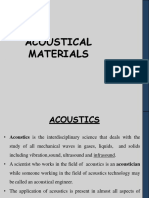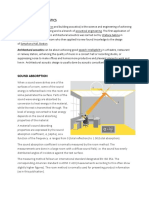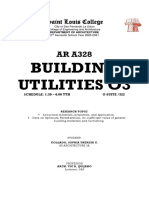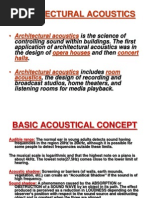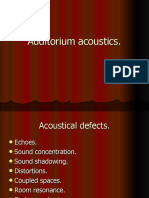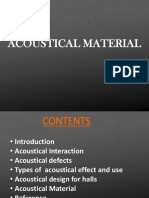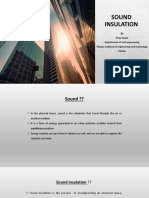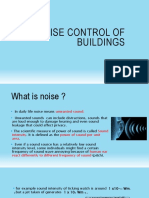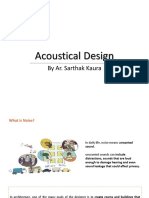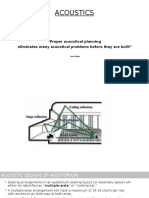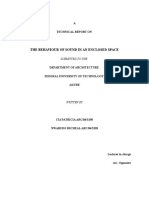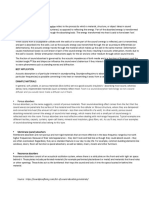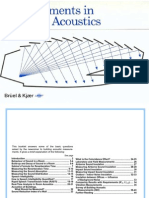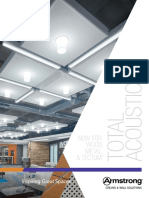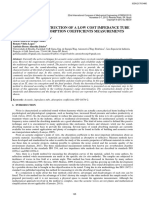0 ratings0% found this document useful (0 votes)
443 viewsAcoustic Materials
Acoustic Materials
Uploaded by
tejaswini C gaurThe document discusses different types of acoustic materials that can be used to absorb sound, including porous materials like mineral wool and foam, membrane absorbers like wood panels and suspended ceilings, and resonance absorbers. It also mentions other sound absorbing materials like carpets, acoustic curtains, acoustic foam panels, and acoustic partitions.
Copyright:
© All Rights Reserved
Available Formats
Download as PDF, TXT or read online from Scribd
Acoustic Materials
Acoustic Materials
Uploaded by
tejaswini C gaur0 ratings0% found this document useful (0 votes)
443 views6 pagesThe document discusses different types of acoustic materials that can be used to absorb sound, including porous materials like mineral wool and foam, membrane absorbers like wood panels and suspended ceilings, and resonance absorbers. It also mentions other sound absorbing materials like carpets, acoustic curtains, acoustic foam panels, and acoustic partitions.
Original Title
acoustic materials
Copyright
© © All Rights Reserved
Available Formats
PDF, TXT or read online from Scribd
Share this document
Did you find this document useful?
Is this content inappropriate?
The document discusses different types of acoustic materials that can be used to absorb sound, including porous materials like mineral wool and foam, membrane absorbers like wood panels and suspended ceilings, and resonance absorbers. It also mentions other sound absorbing materials like carpets, acoustic curtains, acoustic foam panels, and acoustic partitions.
Copyright:
© All Rights Reserved
Available Formats
Download as PDF, TXT or read online from Scribd
Download as pdf or txt
0 ratings0% found this document useful (0 votes)
443 views6 pagesAcoustic Materials
Acoustic Materials
Uploaded by
tejaswini C gaurThe document discusses different types of acoustic materials that can be used to absorb sound, including porous materials like mineral wool and foam, membrane absorbers like wood panels and suspended ceilings, and resonance absorbers. It also mentions other sound absorbing materials like carpets, acoustic curtains, acoustic foam panels, and acoustic partitions.
Copyright:
© All Rights Reserved
Available Formats
Download as PDF, TXT or read online from Scribd
Download as pdf or txt
You are on page 1of 6
ACOUSTIC MATERIALS
INTRODUCTION:
All materials can absorb sound energy to an extent. However,
materials that are specifically noted as sound-absorbing will absorb
most of the sound energy that collides with them.
These specialized materials are usually referred to as "acoustical
materials" and they are designed to have high absorption qualities.
The major use of these materials is to reduce reverberant sound
pressure levels. This leads to a reduction of overall reverberation in
a space
Soundproofing vs. Sound-Absorbing: What’s the difference?
When it comes to acoustics, there are two different options:
You can absorb the reverberant energy that sound creates within a
space.
You can prevent the transmission of sound energy.
The former is referred to as sound-absorbing and the latter is known as soundproofing.
Sound-absorbing materials will absorb most of the sound energy that collides with them and will
reflect very little.
These qualities make them useful in the control of noise within a space or enclosure.
They are used in a variety of locations: close to the source of the noise, paths , or close to
receivers.
Soundproofing a space involves four concepts: adding mass, damping, decoupling, and absorbing.
In practice, sound absorption is a form of soundproofing.
The materials used to soundproof are usually dense and heavy, which allows them to decouple
structures.
Thanks to their density, instead of sound waves penetrating through the structure, they are
reflected back into the space.
Types of Sound Absorbing Materials
There are three primary types of sound absorbers: porous, membrane, and resonance.
POROUS ABSORBERS:
Materials with a high sound absorption coefficient are
usually porous.
Unlike soundproofing materials, sound absorbent
materials aren't dense, they're permeable. Sound waves
penetrate the surface of these materials, and flow into
the fibrous or cellular structure that it's comprised of.
When porous sound absorbers are used, only a small
portion of the sound energy is reflected back into the
space.
• Porous sound absorbers are most effective for mid-range frequencies or treble tones.
They tend to have less effect towards lower frequencies and have minimal effect with
bass.
• Common examples of porous sound absorbers include mineral wool, carpets,
fibreboards, insulation blankets, and certain forms of foam plastic.
Membrane/Plate Absorbers:
A membrane or plate absorber is an air impervious, non-
rigid, non-porous material that's placed over an airspace.
When sound energy is applied to the absorber it causes the
oscillating system to transform into mechanical energy.
They are particularly effective against low-range
frequencies, such as bass.
They also will reflect higher frequency sounds. Other forms
of soundproofing and absorbing will need to be applied to
counter-act this added effect.
Common examples of membrane absorbers are wood or hardboard panelling, suspended plaster
ceilings, windows, wood doors, gypsum boards, and wood floors.
Resonate/Resonance Absorbers
These types of sound absorbers are typically only used
when you need to combat sound in a narrow, yet defined
frequency range.
They're used to focus on issues related to bass
frequencies.
They work in a similar manner to that of a membrane absorber. Meaning they consist
of a mechanical oscillation system with a solid plate and tight air space.
An example of a resonance absorber would be a bottle of Coca-Cola. However, a more
practical example would be layers of perforated plasterboard or perforated metal
corrugated sheets. Where the perforations are the bottle's neck and the space behind
the sheets are the bottle's container.
Carpets and Area Rugs
Carpets and area rugs can help to absorb
impact noise and prevent the transmission of
sound through structures. For instance footfalls
through shared floors/ceilings.
If you have the budget, installing wall to wall
carpet with a sound deadening underlayment is
your best option.
However, wall-to-wall carpet is expensive. A
good substitute are thick area rugs with a layer
of mass loaded vinyl (MLV) affixed to the
bottom. They add mass to the floor and prevent
structure-borne noise.
Acoustic curtains:
Blackout curtains are good for reducing the noise coming in or
getting out from windows and doors.
Use them in a bedroom, home theatre, nursery, or wherever a little
quiet is needed.
A typical acoustic curtain uses quality, heavyweight, plush fabrics
combined soundproofing materials like mass loaded vinyl to
dampen sound and reduce echo.
Industrial noise can be controlled with the installation of sound curtains. These curtains are made
of quilted fiberglass or Rockwool layers, sandwiched over mass loaded vinyl. These curtains are
stiffer than most and hung on frames making them mobile and easy to surround a particularly
noisy piece of equipment or area.
For the home, acoustic curtains are meant to improve the sound in a room, as opposed to blocking
sound from leaving or entering.
Acoustic foam panels:
Acoustic foam panels are made of soft, porous material that feature
notches or cups. Hang them on walls, doors, or ceilings so that
instead of sound waves reflecting off these surfaces, they'll be
absorbed within the porous material.
Acoustic foam panels come in a variety of sizes and colours. For
improved visual appeal, choose a few different colours and hang
them in a pattern on the surface you are applying them to.
Acoustic partition:
Acoustic partition they don’t do a lot to block out
sound, they do offer great sound absorption
capabilities.
These partitions are made of sturdy structural
materials that are covered with porous fabrics that act
as sound absorbers.
Essentially, they act as a large piece of soft furniture in
the middle of an open room.
You might also like
- Acoustical DefectsDocument9 pagesAcoustical Defectsgini0% (1)
- Acoustic Design in BuildingsDocument38 pagesAcoustic Design in BuildingsKritika Dhupar100% (3)
- Architectural Acoustics Assignment - 3Document7 pagesArchitectural Acoustics Assignment - 3SharanyaNo ratings yet
- Acoustic MaterialsDocument6 pagesAcoustic MaterialsLeanne Mae Patuga0% (1)
- AcousticalmaterialDocument40 pagesAcousticalmaterialNagesh PoolaNo ratings yet
- Architectural AcousticsDocument11 pagesArchitectural Acousticsdanielle caycoNo ratings yet
- Building Utilities 3 - Acoustical MaterialsDocument14 pagesBuilding Utilities 3 - Acoustical MaterialsAuthentic SophiaNo ratings yet
- Acoustical MaterialDocument15 pagesAcoustical Materialsaahasitha 14No ratings yet
- Architectural Acoustics 5Document9 pagesArchitectural Acoustics 5Davezel ZerxNo ratings yet
- Architectural Acoustics: Building Utilities 3 - Acoustics and Lighting Systems (Topic 1)Document23 pagesArchitectural Acoustics: Building Utilities 3 - Acoustics and Lighting Systems (Topic 1)Davezel ZerxNo ratings yet
- Acoustics For Home TheatresDocument10 pagesAcoustics For Home TheatresAnvitha S100% (2)
- Assignment 2: List of Acoustical DefectsDocument6 pagesAssignment 2: List of Acoustical DefectsRaj MaheshwariNo ratings yet
- Architectural Acoustics123Document56 pagesArchitectural Acoustics123anshita_845695825No ratings yet
- Auditorium AcousticsDocument17 pagesAuditorium AcousticsTanyaNo ratings yet
- Sound Absorption GRP3Document27 pagesSound Absorption GRP3KEVIN JUGONo ratings yet
- Acoustical MaterilasDocument34 pagesAcoustical MaterilasMuthuveerappan Chockalingam100% (1)
- Architectural Acoustics Assignment - 6Document7 pagesArchitectural Acoustics Assignment - 6SharanyaNo ratings yet
- Building Utilities 3: Room AcousticsDocument11 pagesBuilding Utilities 3: Room AcousticsIzzah LNo ratings yet
- Acoustical Design of SpacesDocument21 pagesAcoustical Design of SpacesLaNZ Nesirio100% (1)
- Room Acoustic Lecture 2 PDFDocument68 pagesRoom Acoustic Lecture 2 PDFSeid AbdulefetahNo ratings yet
- ACOUSTICSDocument10 pagesACOUSTICSNupur BhadraNo ratings yet
- Acoustics: Architectural Building ServicesDocument20 pagesAcoustics: Architectural Building ServicesGauri WaikarNo ratings yet
- Acoustics & Sound Insulation: 2 Year B.SCDocument14 pagesAcoustics & Sound Insulation: 2 Year B.SCKomal ChopadaNo ratings yet
- Acoustics 3 Acous - MaterialDocument7 pagesAcoustics 3 Acous - MaterialNaveen Kumar NilNo ratings yet
- Acoustical MaterialDocument31 pagesAcoustical MaterialVISHAL SHARMANo ratings yet
- Acoustics Materials in ArchitectureDocument17 pagesAcoustics Materials in ArchitectureGurjeet SinghNo ratings yet
- Sound InsulationDocument33 pagesSound InsulationMukulNo ratings yet
- Architectural AcousticsDocument22 pagesArchitectural AcousticsYeabtsega ZelalemNo ratings yet
- Sound Absorbing Materials and ConstructionsDocument60 pagesSound Absorbing Materials and Constructionsss100% (1)
- Building Acoustics TerminologyDocument10 pagesBuilding Acoustics TerminologyanhnguyenhaiNo ratings yet
- Architectural Acoustics 2Document12 pagesArchitectural Acoustics 2Leonoralynn SapunganNo ratings yet
- Acaustics PDFDocument35 pagesAcaustics PDFKishan SirohiNo ratings yet
- Acoustic Materials and Their Different TypesDocument8 pagesAcoustic Materials and Their Different TypesMimi EDCNo ratings yet
- Acoustics and IlluminationDocument109 pagesAcoustics and IlluminationKratika100% (1)
- Acoustic in An Auditorium: - Submitted By: - Swapnil Nimbhorkar - Final Year Part-2 - B-ArchitectureDocument37 pagesAcoustic in An Auditorium: - Submitted By: - Swapnil Nimbhorkar - Final Year Part-2 - B-Architecturerahul sulakhe100% (1)
- Acoustics and LightingDocument16 pagesAcoustics and LightingDaryl Gomez TimatimNo ratings yet
- 7 AcousticsDocument23 pages7 AcousticsSummer Yeoreumie100% (1)
- ARCHITECTURAL ACOUSTICS (Edited)Document10 pagesARCHITECTURAL ACOUSTICS (Edited)project jade100% (1)
- Construction Materials For Acoustic DesignDocument35 pagesConstruction Materials For Acoustic DesignRukminiPriyanka100% (1)
- Building Services Module 3 NotesDocument63 pagesBuilding Services Module 3 NotesTrishul IsNo ratings yet
- Acoustic MaterialDocument31 pagesAcoustic MaterialRadzidi GdNo ratings yet
- Acoustic MaterialsDocument13 pagesAcoustic MaterialsJm Baro100% (1)
- Building AcousticsDocument43 pagesBuilding AcousticsNupur Bhadra81% (21)
- Acoustics of Enclosed SpaceDocument47 pagesAcoustics of Enclosed SpaceAnusha Ivaturi0% (1)
- Civil Noise Control of BuildingsDocument10 pagesCivil Noise Control of BuildingsFajar Karunia50% (2)
- Noise Control of Buildings: Presented by Anandu K PDocument17 pagesNoise Control of Buildings: Presented by Anandu K PensecNo ratings yet
- Behaviour of Sound in An Enclosed SpaceDocument15 pagesBehaviour of Sound in An Enclosed SpaceAnusha Ivaturi100% (1)
- Acoustical Design: by Ar. Sarthak KauraDocument34 pagesAcoustical Design: by Ar. Sarthak KauraPaapu DeviNo ratings yet
- Acoustics Lec 2Document13 pagesAcoustics Lec 2Chandan KumarNo ratings yet
- Behaviour of Sound in An Enclosed SpaceDocument14 pagesBehaviour of Sound in An Enclosed Spacesanchit gupta100% (1)
- Home TheaterDocument13 pagesHome Theatermaddabdul100% (1)
- Chapter 4: Insulation: Sound - IntroductionDocument14 pagesChapter 4: Insulation: Sound - IntroductionYu HanaNo ratings yet
- Bs 3 Unit 5aDocument28 pagesBs 3 Unit 5aPavithra SivasankaranNo ratings yet
- Acoustics and LightingDocument41 pagesAcoustics and LightingShaina Marie GanotisiNo ratings yet
- Sound Absorbers PresentationDocument9 pagesSound Absorbers Presentationkit spark0% (1)
- Bu3 20 List Sound Absorption Material RafDocument12 pagesBu3 20 List Sound Absorption Material Rafgraceeydy19No ratings yet
- Thesis CH 4Document9 pagesThesis CH 4princesslayshoonNo ratings yet
- Acoustic MaterialsDocument7 pagesAcoustic MaterialsZamran AlamNo ratings yet
- AcousticsDocument2 pagesAcousticsEldon SatoNo ratings yet
- Acoustic WallDocument26 pagesAcoustic WallIshita SehgalNo ratings yet
- Acoustics and ArchitectureDocument46 pagesAcoustics and ArchitectureAbraham BongolanNo ratings yet
- Study The Rheological and Mechanical Properties of PVADocument7 pagesStudy The Rheological and Mechanical Properties of PVAiisteNo ratings yet
- The Acoustical Design of The New Lecture AuditoriumDocument18 pagesThe Acoustical Design of The New Lecture AuditoriumYadram YadavNo ratings yet
- Sound Absorption Data For Common Building Materials and FurnishingsDocument3 pagesSound Absorption Data For Common Building Materials and FurnishingsMikaela Alyssa Reyes VillagraciaNo ratings yet
- K-Fonic Poduct DetailsDocument28 pagesK-Fonic Poduct DetailsAshish VaidNo ratings yet
- Noise Control in BuildingsDocument36 pagesNoise Control in BuildingsEmily Ong100% (1)
- Soundproofing Solutions - en - 2020 - 04Document180 pagesSoundproofing Solutions - en - 2020 - 04Marius Babos100% (1)
- Case Study:: Conference RoomDocument14 pagesCase Study:: Conference RoomTania NatiolaNo ratings yet
- LESSON 3 - Reverberation TimeDocument18 pagesLESSON 3 - Reverberation TimeMonique TierraNo ratings yet
- Acoustics-5 Constructional Acoustic MaterialDocument110 pagesAcoustics-5 Constructional Acoustic MaterialMOHD AZHAR NUMANINo ratings yet
- 9.astm E90 - 09Document15 pages9.astm E90 - 09Raj SekarNo ratings yet
- Room AcousticsDocument5 pagesRoom AcousticsLaura PopescuNo ratings yet
- AcousticsDocument46 pagesAcousticsbzkizo_sbbNo ratings yet
- Assignment - 3: Theatre of Connexion Nexus - Kaula Lumpur, MalaysiaDocument10 pagesAssignment - 3: Theatre of Connexion Nexus - Kaula Lumpur, MalaysiaPreethi NandagopalNo ratings yet
- Fundamentals of Architectural Acoustics: Building Skin EnvelopeDocument85 pagesFundamentals of Architectural Acoustics: Building Skin EnvelopeROA ARCHITECTSNo ratings yet
- Fundamentals of AcousticsDocument30 pagesFundamentals of AcousticsYean Ghing TongNo ratings yet
- Acoustical Analysis of Kennedy Auditorium, India: Concert Hall Acoustics: Paper ICA2016-761Document9 pagesAcoustical Analysis of Kennedy Auditorium, India: Concert Hall Acoustics: Paper ICA2016-761ironmanNo ratings yet
- Total Acoustics BrochureDocument16 pagesTotal Acoustics BrochureydrasNo ratings yet
- Sound Sources Used For Testing Open Office Components and SystemsDocument2 pagesSound Sources Used For Testing Open Office Components and SystemsNada KhlifNo ratings yet
- AssignmentDocument10 pagesAssignmentswarna raviNo ratings yet
- Basic of AcousticsDocument22 pagesBasic of AcousticsDonavan Tadia Cabantac100% (1)
- Environmental Science ReportDocument16 pagesEnvironmental Science Report薇神No ratings yet
- Knauf Ebook Acoustic Design in HealthDocument20 pagesKnauf Ebook Acoustic Design in HealthVikas VarmaNo ratings yet
- Review of Related Literature and StudiesDocument14 pagesReview of Related Literature and StudiesNew0trickNo ratings yet
- KNC Brochure Fabric Panels Diffusers and ReflectorsDocument15 pagesKNC Brochure Fabric Panels Diffusers and Reflectors2226558No ratings yet
- Reverberation Time Computation: Reflecting The EnergyDocument4 pagesReverberation Time Computation: Reflecting The EnergyEleisha M. EbreoNo ratings yet
- Sound Absorbing and Insulating Properties of Natural Fiber Hybrid Composites Using Sugarcane Bagasse and Bamboo CharcoalDocument10 pagesSound Absorbing and Insulating Properties of Natural Fiber Hybrid Composites Using Sugarcane Bagasse and Bamboo CharcoalSarc AmpoonNo ratings yet
- Setupand Postprocessing and LabviewDocument11 pagesSetupand Postprocessing and LabviewtruptiNo ratings yet
- As ISO 140.4-2006 Acoustics - Measurement of Sound Insulation in Buildings and of Building Elements Field MeaDocument8 pagesAs ISO 140.4-2006 Acoustics - Measurement of Sound Insulation in Buildings and of Building Elements Field MeaSAI Global - APACNo ratings yet




